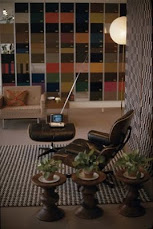I have been obsessed with this spectacular since I first saw it. Please, if you know where I can get a copy of the whole thing, let me know. Beware of other "Fabulous Fifties" things which are not the real deal.
Wednesday, January 28, 2009
Saturday, January 17, 2009
ModoDonkey Revealed

Here's a side table/bookshelf/laptop cart I designed and built. I'm calling it the ModoDonkey in reference to the Penguin Donkey [see post below] of yore. It's made out of one 4x4 sheet of birch plywood and four metal casters. I learned during this process that I am much more interested in the design stage of the process than the construction. Luckily, I discovered wood filler. For larger, future projects, I'm going to design the piece and get a cabinet maker to properly cut and assembly any boxy sections I really need square.
I'm pretty happy with the piece. It is very useful, and fits nicely in our modest, modern aesthetic. The idea is that one side you can place coffee table books and magazines. On the other, DVDs or books I'm currently reading. I cut a hole in each end so the table can easily be pulled over to my chair. Also, the design fits DVDs and paperbacks on two sides. I'm using the back side to store Nintendo Wii gear. It's great for keeping things out of sight, and the kids are into putting things away in this "secret compartment."

Monday, January 05, 2009
ModoDonkey Side Table: Design Inspiration
In the last day or two I've been indulging my interests in modern design (while not working on research or prepping courses) by designing and building an occasional side table/book & media storage unit inspired by midcentury and industrial design. I've been wanting another sidetable because I'm constantly moving them around in my living room depending on whether I'm watching TV, reading, or on the laptop. I don't like coffeetables because they mostly get in the way of foot traffic and attract clutter. I also have a thing for pocket paperbacks from the 50s and 60s. I love the compact design, and the fact that you can load up on classics for less than $1 a pop. (Currently I'm reading Saul Bellow's Herzog). Reading these is a tactile experience (when will the spine break? which pages will fall out first?) almost as much as an intellectual one.
I latched on to a very unique storage table from the 1930s called the Penguin Donkey, especially designed to be stuffed full of Penguin pocketbooks on two sides, with space in the middle for newspapers or magazines. Unfortunately, the tops of this are bent plywood, which looks great, but is extremely difficult to balance a cup of coffee on. Isokon has built a couple of more models, including the Donkey 3, which is cool, but more money than I'm willing to pay. Also, it has four legs, and I wanted something I could easily move a couple of feet from a nice balanced spot on the wall under a poster to coffee or laptop position.
Inspiration: the handy side tables we bought 2 @ $30 from our vintage furniture dealer when we bought our house. They're incredibly simple and useful, with a white laminate top, easily transportable, and scaled just perfectly. I sometimes put both of them together, one with laptop, one with coffee, to work at the TV. The new piece would have to live in relative harmony with these, but I wanted something to show off paperbacks and the occasional coffee table book as well. As the piece took shape, I also realized it would give me a chance to hide away the slowly growing number of Wii games stacked next to the TV, and, more importantly, the gangly Wii controllers.

Other inspiration: the Case Study bed from Modernica via Design Within Reach we've had since our son (child #2) was born (child #1: bought four door car, child #2: bought Case Study bed for son to be born in, child #3: bought bigger car and house. no more kids, no more big purchases on the horizon.) The birch plywood headboard on the bed is so simple and striking with just a clear semigloss coat. I decided to make the entire table out of birch plywood, as that seemed in line not only with minimalist, modernist aesthetics, but my minimalist carpentry skills.
Design guidelines: #1 the height of my favorite side tables; #2 the height and depth of my Herzog paperback; #3 the dimensions of my Julius Schulman coffeetable book. I checked the plans to see if they would also accomodate DVD boxes, and lucked out. So the inspirations guiding the design are midcentury, even if the media contained are 21st century. I designed a 14 inch deep side table, 20 inches high (with casters), 24 inches wide. Half the table will be one large compartment for coffeetable size books and magazines. The other half will have two shelves on both sides of the table, retaining the donkey saddlebag design of the original Penguin Donkey. This means you can spin the table around to find more books or DVDs, etc. It also means I've got an excuse for loading up on a bunch more cheap, quality pocket paperbacks. I'm cutting a 2.5 inch diameter hole in each end piece for carrying the table, or--more importantly--grabbing it from my chair to pull toward me to put a beverage or laptop on.
It took a little more thinking to figure how to take care of the mobile component of the table. Frankly, since I was inspired by the Isokon donkeys, I figured I'd give it four feet and just gently move it around. But I looked through one of my favorite books, High-Tech, which is a classic design book from the 1970s on using industrial design in the home. In that book, I hit upon what was really a no-brainer: caster wheels. I lucked out and my Lowe's had some great 2.5 inch tall steel ones that were a great match for the plywood body.
Another valuable source for the project was Todd Oldham's book, Handmade Modern. The book contains 50 or so projects, many of which are lame, but many of which also provide some inspiration and nuts-and-bolts know-how for building small furniture. It's kind of like a tourist guidebook--you might not do what's in the book, but it gives you the confidence to set out and do something.
I figured out how to get all the necessary wood from a 4' by 4' sheet of birch plywood (which Lowe's had for about $27) with very little scrap leftover. I had a budget of $50 for the project, but having to buy a can of polyurethane and a hole-cutting bit added $25. I'm out of Lowe's for $80. Which means not only that I can't spend any more money, but that I need to make and sell another one of these things (or two. interested?)
Here's something totally unexpected that shares the minimalist plywood aesthetic: furniture by Donald Judd (?).
I latched on to a very unique storage table from the 1930s called the Penguin Donkey, especially designed to be stuffed full of Penguin pocketbooks on two sides, with space in the middle for newspapers or magazines. Unfortunately, the tops of this are bent plywood, which looks great, but is extremely difficult to balance a cup of coffee on. Isokon has built a couple of more models, including the Donkey 3, which is cool, but more money than I'm willing to pay. Also, it has four legs, and I wanted something I could easily move a couple of feet from a nice balanced spot on the wall under a poster to coffee or laptop position.
Inspiration: the handy side tables we bought 2 @ $30 from our vintage furniture dealer when we bought our house. They're incredibly simple and useful, with a white laminate top, easily transportable, and scaled just perfectly. I sometimes put both of them together, one with laptop, one with coffee, to work at the TV. The new piece would have to live in relative harmony with these, but I wanted something to show off paperbacks and the occasional coffee table book as well. As the piece took shape, I also realized it would give me a chance to hide away the slowly growing number of Wii games stacked next to the TV, and, more importantly, the gangly Wii controllers.

Other inspiration: the Case Study bed from Modernica via Design Within Reach we've had since our son (child #2) was born (child #1: bought four door car, child #2: bought Case Study bed for son to be born in, child #3: bought bigger car and house. no more kids, no more big purchases on the horizon.) The birch plywood headboard on the bed is so simple and striking with just a clear semigloss coat. I decided to make the entire table out of birch plywood, as that seemed in line not only with minimalist, modernist aesthetics, but my minimalist carpentry skills.
Design guidelines: #1 the height of my favorite side tables; #2 the height and depth of my Herzog paperback; #3 the dimensions of my Julius Schulman coffeetable book. I checked the plans to see if they would also accomodate DVD boxes, and lucked out. So the inspirations guiding the design are midcentury, even if the media contained are 21st century. I designed a 14 inch deep side table, 20 inches high (with casters), 24 inches wide. Half the table will be one large compartment for coffeetable size books and magazines. The other half will have two shelves on both sides of the table, retaining the donkey saddlebag design of the original Penguin Donkey. This means you can spin the table around to find more books or DVDs, etc. It also means I've got an excuse for loading up on a bunch more cheap, quality pocket paperbacks. I'm cutting a 2.5 inch diameter hole in each end piece for carrying the table, or--more importantly--grabbing it from my chair to pull toward me to put a beverage or laptop on.
It took a little more thinking to figure how to take care of the mobile component of the table. Frankly, since I was inspired by the Isokon donkeys, I figured I'd give it four feet and just gently move it around. But I looked through one of my favorite books, High-Tech, which is a classic design book from the 1970s on using industrial design in the home. In that book, I hit upon what was really a no-brainer: caster wheels. I lucked out and my Lowe's had some great 2.5 inch tall steel ones that were a great match for the plywood body.
Another valuable source for the project was Todd Oldham's book, Handmade Modern. The book contains 50 or so projects, many of which are lame, but many of which also provide some inspiration and nuts-and-bolts know-how for building small furniture. It's kind of like a tourist guidebook--you might not do what's in the book, but it gives you the confidence to set out and do something.
I figured out how to get all the necessary wood from a 4' by 4' sheet of birch plywood (which Lowe's had for about $27) with very little scrap leftover. I had a budget of $50 for the project, but having to buy a can of polyurethane and a hole-cutting bit added $25. I'm out of Lowe's for $80. Which means not only that I can't spend any more money, but that I need to make and sell another one of these things (or two. interested?)
Here's something totally unexpected that shares the minimalist plywood aesthetic: furniture by Donald Judd (?).
Subscribe to:
Posts (Atom)











